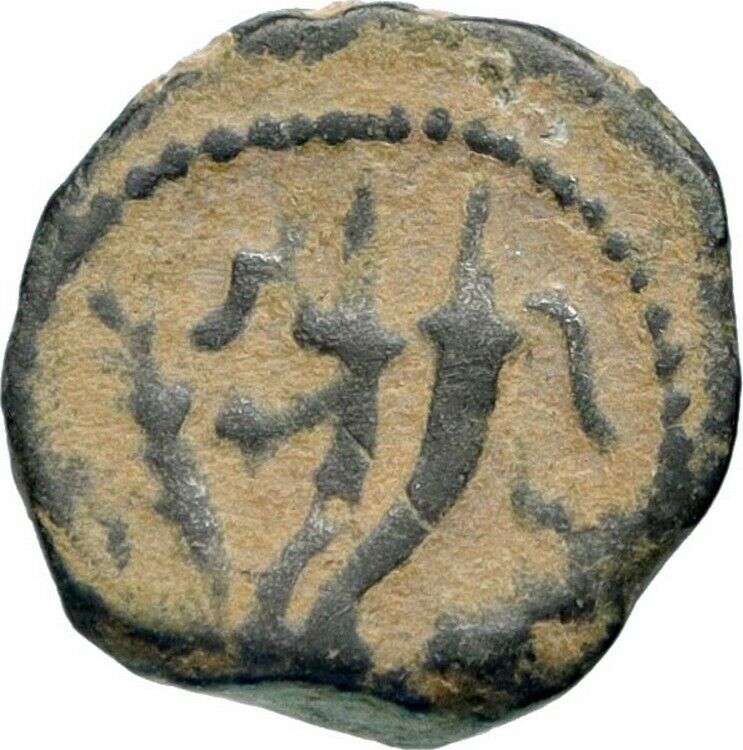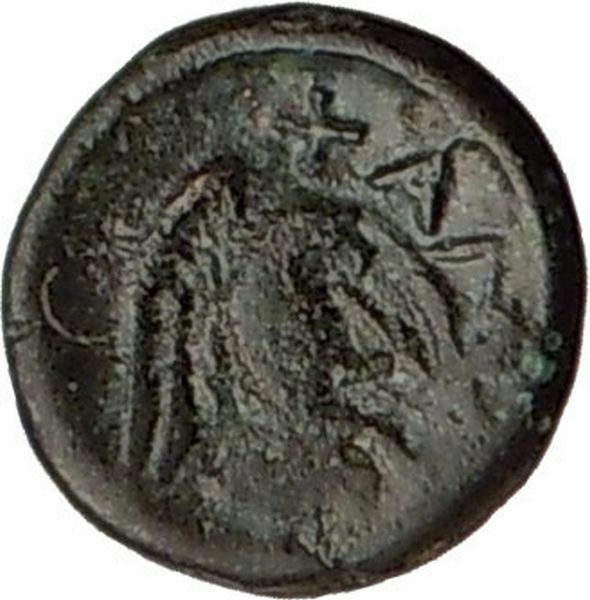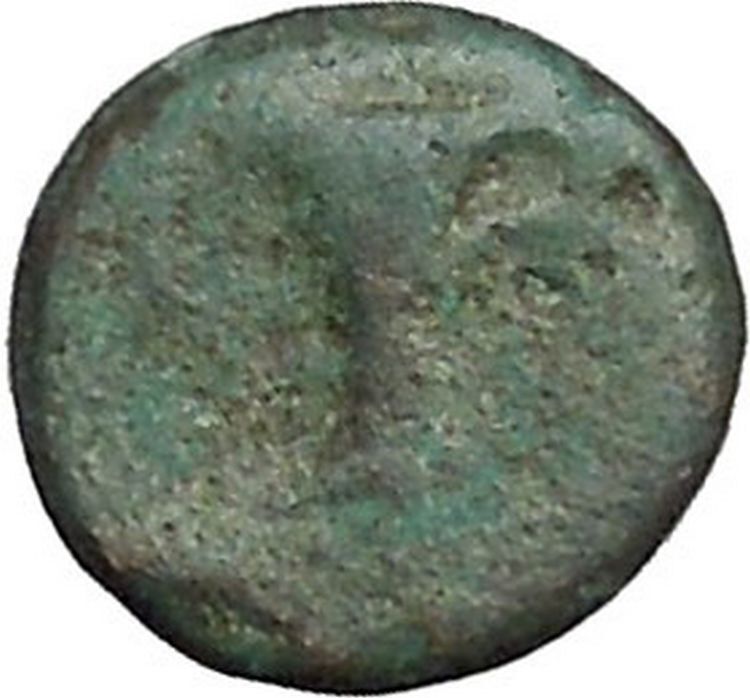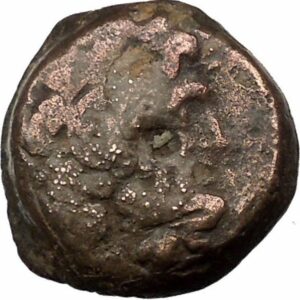|
Greek city of
Pantikapaion
in
Tauric Chersonesos
Bronze 14mm (3.14 grams) Struck 3rd-2nd Centuries B.C.
Reference: Rare, possibly unpublished type!
Helmeted head of
Ares
right.
ΠΑΝ,
Forepart of
galley
right..
You are bidding on the exact item pictured,
provided with a Certificate of Authenticity and Lifetime Guarantee of
Authenticity.
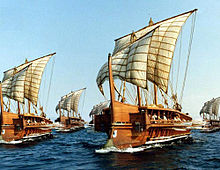
A
galley is a type
of ship
propelled by
rowers
that originated in the eastern
Mediterranean Sea
and was used for
warfare
,
trade
and
piracy
from the first millennium BC. Galleys
dominated
naval warfare
in the Mediterranean from the 8th
century BC until development of advanced sailing warships in the 17th century.
Galleys fought in the wars of
Assyria
, ancient
Phoenicia
,
Greece
,
Carthage
and
Rome
until the 4th century AD. After the fall
of the
Western Roman Empire
galleys formed the
mainstay of the
Byzantine navy
and other navies of successors
of the Roman Empire, as well as new
Muslim
navies. Medieval Mediterranean states,
notably the Italian maritime republics, including
Venice
,
Pisa
,
Genoa
and the
Ottoman Empire
relied on them as the primary
warships of their fleets until the 17th century, when they were gradually
replaced by sailing warships. Galleys continued to be applied in minor roles in
the Mediterranean and the
Baltic Sea
even after the introduction of
steam propelled
ships in the early 19th
century.
The galley engagements at
Actium
and
Lepanto
are among the greatest
naval battles
in history.
Ares is the
Greek god
of war
. He is one of the
Twelve Olympians
, and the son of
Zeus and Hera
. In
Greek literature
, he often represents the
physical or violent aspect of war, in contrast to the armored
Athena
, whose functions as a
goddess of intelligence
include
military strategy
and
generalship
.
The Greeks were
a class=”extiw” title=”wiktionary:ambivalent” href=”https://en.wiktionary.org/wiki/ambivalent#English”>
ambivalent toward Ares: although he embodied
the physical valor necessary for success in war, he was a dangerous force,
“overwhelming, insatiable in battle, destructive, and man-slaughtering.” Fear
(Phobos)
and Terror (Deimos)
were yoked to his battle
chariot
. In the
Iliad
his father Zeus tells him that he is
the god most hateful to him. An association with Ares endows places and objects
with a savage, dangerous, or militarized quality. His value as a war god is even
placed in doubt: during the
Trojan War
, Ares was on the losing side, while
Athena, often depicted in
Greek art
as holding
Nike (Victory)
in her hand, favored the
triumphant Greeks.
Ares plays a relatively limited role in
Greek mythology
as represented in literary
narratives, though his numerous love affairs and abundant offspring are often
alluded
to. When Ares does appear in myths, he
typically faces humiliation. He is well known as the lover of
Aphrodite
, the goddess of love who was married
to Hephaestus
, god of craftsmanship,
but the most famous story involving the couple shows them exposed to ridicule
through the wronged husband’s clever device.
The counterpart of Ares among the
Roman gods
is
Mars
, who as a father of the Roman people held
a more important and dignified place in
ancient Roman religion
for his agricultural and
tutelary
functions. During the
Hellenization
of
a title=”Latin literature” href=”https://en.wikipedia.org/wiki/Latin_literature”>
Latin literature, the myths of Ares were
reinterpreted
by Roman writers under the name
of Mars. Greek writers under
Roman rule
also recorded
cult practices
and beliefs pertaining to Mars
under the name of Ares. Thus in the
classical tradition
of later
Western art and literature
, the mythology of
the two figures becomes virtually indistinguishable.
Names and epithets
The etymology of the name Ares is traditionally connected with the
Greek
word ἀρή (arē), the
Ionic
form of the
Doric
ἀρά (ara), “bane, ruin,
curse, imprecation”.
There may also be a connection with the Roman god of war
Mars
, via hypothetical
Proto-Indo-European
*M̥rēs;compare Ancient Greek μάρναμαι (marnamai),
“to fight, to battle”, or Punjabi maarna (to kill, to hit).
The earliest attested form of the name is the
Mycenaean Greek
a-re, written in
Linear B
syllabic script.
Walter Burkert
notes that “Ares is apparently
an ancient abstract noun meaning throng of battle, war.”
The adjectival
epithet
Areios was frequently appended
to the names of other gods when they take on a warrior aspect or become involved
in warfare: Zeus Areios, Athena Areia, even Aphrodite Areia.
In the Iliad, the word ares is used as a
common noun
synonymous with “battle.”
Inscriptions as early as
Mycenaean
times, and continuing into the
Classical period
, attest to
Enyalios
, another name for the god of war.
Character and origins
Ares was one of the Twelve Olympians in the archaic tradition represented by
the Iliad
and
Odyssey
, but Zeus expresses a recurring
Greek revulsion toward the god when Ares returns wounded and complaining from
the battlefield at Troy
:
Then looking at him darkly Zeus who gathers the clouds spoke to him:
‘Do not sit beside me and whine, you double-faced liar.
To me you are the most hateful of all gods who hold Olympos.
Forever quarrelling is dear to your heart, wars and battles.
…
And yet I will not long endure to see you in pain, since
you are my child, and it was to me that your mother bore you.
But were you born of some other god and proved so ruinous
long since you would have been dropped beneath the gods of the bright sky.”
This ambivalence is expressed also in the god’s association with the
Thracians
, who were regarded by the Greeks as a
barbarous and warlike people.
Thrace
was Ares’ birthplace, true home, and
refuge after the affair with Aphrodite was exposed to the general mockery of the
other gods.
A late 6th-century BC funerary inscription from
Attica
emphasizes the consequences of coming
under Ares’ sway:
Stay and mourn at the tomb of dead Kroisos
Whom raging Ares destroyed one day, fighting in the foremost ranks.
In
Macedonia
, however, he was viewed as a bearded
war veteran with superb military skills and physical strength. The
ancient Macedonians
looked up to Ares as a
divine leader as well as a god.[citation
needed] In
Sparta
Ares was viewed as a
masculine
soldier in which his resilience,
physical strength and military intelligence was unrivaled.[citation
needed]
Attributes

The
Ares Borghese
The birds of Ares (Ornithes Areioi) were a flock of
feather-dart-dropping birds that guarded the
Amazons
‘ shrine of the god on a
coastal
island
in the
Black Sea
.
Vultures and dogs, both of which prey upon carrion in the battlefield, were
sacred
to him.[citation
needed]
Cult and ritual
Although Ares received occasional sacrifice from armies going to war, the god
had a formal temple and cult at only a few sites.
At Sparta
, however, youths each sacrificed a puppy
to
Enyalios
before engaging in ritual fighting at
the Phoebaeum.
The chthonic
night-time sacrifice of a dog to
Enyalios became assimilated to the cult of Ares.[citation
needed]
Just east of Sparta stood an archaic statue of the god in chains, to show
that the spirit of war and victory was never to leave the city.
The
temple
to Ares in the
agora
of
Athens
that
Pausanias
saw in the second century AD had only
been moved and rededicated there during the time of
Augustus
; in essence it was a
Roman temple
to the Augustan
Mars Ultor
.
The Areopagus
, the “mount of Ares” where
Paul of Tarsus
preached, is sited at some
distance from the Acropolis; from archaic times it was a site of trials. Its
connection with Ares, perhaps based on a false etymology, is purely
etiological myth
.[citation
needed] A second temple has also been located at the
archaeological site of
Metropolis
in what is now Western
Turkey
.
Attendants
Deimos
, “Terror” or “Dread”, and
Phobos
, “Fear”, are his companions in war
and also his children, borne by
Aphrodite
, according to
Hesiod
.
The sister and companion of the violent Ares is
Eris
, the goddess of discord, or
Enyo, the goddess of war, bloodshed, and violence. Enyalius, rather
than another name for Ares, in at least one tradition was his son by Enyo.
Ares may also be accompanied by
Kydoimos
, the demon of the din of battle; the
Makhai
(“Battles”); thev “Hysminai” (“Acts of
manslaughter”); Polemos
, a minor spirit of war, or only an
epithet of Ares, since it has no specific dominion; and Polemos’s daughter,
Alala
, the
goddess
or
personification
of the Greek war-cry, whose
name Ares uses as his own war-cry. Ares’s sister
Hebe
, “Youth,” also draws baths for him.
According to
Pausanias
, local inhabitants of
Therapne
,
Sparta
, recognized
Thero
“feral, savage” as a nurse of Ares.
Founding of Thebes
One of the roles of Ares that was sited in mainland Greece itself was in the
founding myth
of Thebes: Ares was the
progenitor of the water-dragon slain by
Cadmus
, for the dragon’s teeth were sown into
the ground as if a crop and sprung up as the fully armored
autochthonic
Spartoi
. To propitiate Ares, Cadmus took as a
bride
Harmonia
, daughter of Ares’ union with
Aphrodite, thus harmonizing all strife and founding the city of Thebes.
Consorts and children

The
Areopagus
as viewed from the
Acropolis
.
The union of Ares and Aphrodite created the gods
Eros, Anteros
,
Phobos
,
Deimos
,
Harmonia
, and
Adrestia
. While Eros and Anteros’ godly
stations favored their mother, Adrestia by far preferred to emulate her father,
often accompanying him to war.[citation
needed]
Ares, upon one occasion, incurred the anger of
Poseidon
by slaying his son
Halirrhothius
, who had raped Alcippe, another
daughter of the war-god. For this deed, Poseidon summoned Ares to appear before
the tribunal of the Olympic gods, which was held upon a hill in Athens. Ares was
acquitted, and this event is supposed to have given rise to the name
Areopagus
(or Hill of Ares), which afterward
became famous as a court of justice.
There are accounts of a son of Ares,
Cycnus
(Κύκνος) of
Macedonia
, who was so murderous that he tried
to build a temple with the skulls and the bones of travellers.
Heracles
slaughtered this abominable
monstrosity, engendering the wrath of Ares, whom the hero wounded
Panticapaeum (Greek:
Παντικάπαιον, Pantikápaion), present-day
Kerch
: an
important
Greek
city and port in Taurica
(Tauric Chersonese), situated on a hill (Mt.
Mithridates
) on the western side of the
Cimmerian Bosporus
, founded by
Milesians
in
the late 7th–early 6th century BC.
In the 5th–4th centuries BC, the city became the residence first of the
Archaeanactids
and then of the
Spartocids
,
dynasties of
Greek
kings of
Bosporus
, and was hence itself sometimes called Bosporus. Its economic
decline in the 4th–3rd centuries BC was the result of the
Sarmatian
conquest of the steppes and the growing competition of
Egyptian
grain. The last of the
Spartocids
,
Paerisades V
, apparently left his realm to
Mithridates VI
Eupator, king of
Pontus
.
This transition was arranged by one of Mithridates’s generals, a certain
Diophantus
, who earlier was sent to Taurica to help local Greek cities
against Palacus
of
Lesser Scythia
. The takeover didn’t go smoothly: Paerisades was murdered by
Scythians
led by
Saumacus
,
Diophantus
escaped to return later with reinforcements and to suppress the
revolt (c. 110 BC).
Half of a century later, Mithridates himself took his life in Panticapaeum,
when, after his defeat in a
war
against
Rome
,
his own son and heir
Pharnaces
and citizens of Panticapaeum turned against him. In 63 BC the city
was partly destroyed by an earthquake. Raids by the
Gothss
and the
Huns furthered its
decline, and it was incorporated into the
Byzantine
state under
Justin I
in
the early 6th century AD.

Ruins of Panticapaeum in
Kerch
(Ukraine)
During the first centuries of the city’s existence, imported Greek articles
predominated: pottery
Kerch
Style), terracottas
, and metal objects, probably from workshops in
Rhodes
,
Corinth
,
Samos
,
and Athens
.
Local production, imitated from the models, was carried on at the same time.
Athens manufactured a special type of bowl for the city, known as
Kerch
ware. Local
potters imitated the
Hellenistic
bowls known as the
Gnathia
style as well as relief wares—Megarian
bowls. The city minted silver coins from the mid 6th century BC and from the 1st
century BC gold and bronze coins. The
Hermitage
and Kerch
Museums contain material from the site, which is still being
excavated.
Bibliography
-
Noonan, Thomas S.
“The Origins of the Greek Colony at Panticapaeum”,
American Journal of Archaeology, Vol. 77, No. 1. (1973), pp. 77–81.
|










